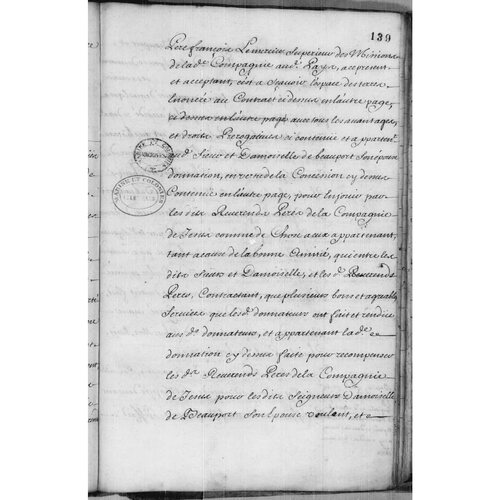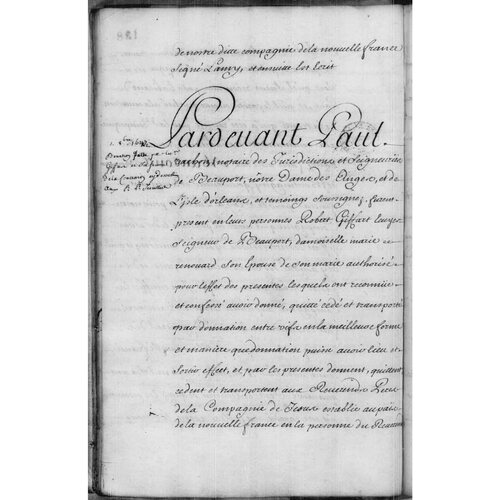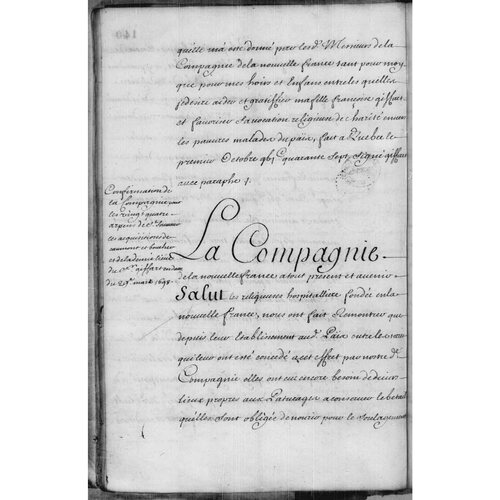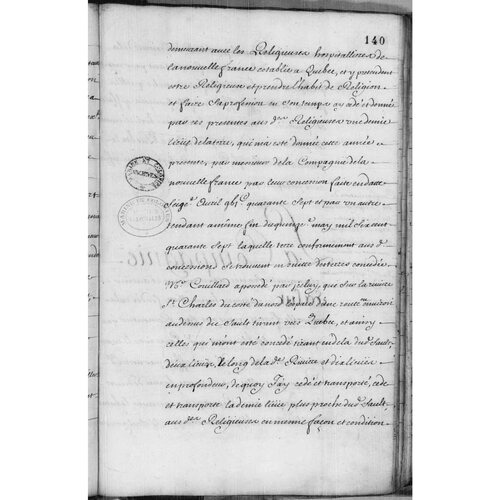GIFFARD DE MONCEL, ROBERT, master surgeon, colonizing seigneur, member of the Communauté des Habitants, first doctor of the Hôtel-Dieu of Quebec and doctor in ordinary to the king; b. c. 1589, the son of Guillaume Giffard and Louise Viron, in the parish of Autheuil (Orne, France); d. 14 April 1668 at Beauport and was buried there two days later.
His marriage contract with Marie Regnouard was drawn up on 12 Feb. 1628 at Mortagne. Established at Beauport, less than two leagues from Quebec, Giffard was the first colonizing seigneur in New France. This vocation was superimposed upon that of “naval surgeon,” a title that he bore in 1627, when mention of his coming to Canada was first made. He became the first doctor of the Hôtel-Dieu of Quebec in 1640, apothecary, and even “doctor in ordinary” to the king in 1647, a purely honorary title which crowned his career and his prestige.
At the time of his voyage in 1627, if not sooner, Giffard had built himself a “cabin” at La Canardière, in the region of Beauport, probably for hunting and fishing. Apparently he already intended to settle in the colony, since, when he came back in 1628 with Roquemont’s fleet, bringing with him a considerable amount of equipment, he was captured and despoiled by the Kirkes near Tadoussac. Later the Compagnie de la Nouvelle-France recognized his attempt at colonization and indemnified him for “the losses that he incurred in this context when he was captured with the fleet.”
He returned to France, but in 1634 came back to Canada for good, with his wife and two children. The company, which was having difficulties in meeting its obligations with respect to immigration, had just granted him, on 15 January, one of the first seigneuries in Canada, “a league of ground to be taken up along the shore of the St. Lawrence River for a depth of a league and a half inland, at the place where the River called Notre Dame de Beauport flows into the said St. Lawrence River, the first-mentioned river being included within the area.” The document stipulated that in return the colonists brought out by Giffard “will be credited to the said Company, to reduce the number that it is to send out,” and this “without the said Giffard being allowed however to trade in furs and pelts at the said place or elsewhere in New France.”
Robert Giffard was therefore launching what was solely a colonizing enterprise, and as early as 1634 he concluded at Mortagne a hiring agreement with Jean Guyon Du Buisson senior and Zacharie Cloutier to take them forthwith to Canada, each being accompanied by one of his children, to begin the operations of land-clearing and settling. This was the starting-point of what has been called the immigration from the Perche, which was continued by Noël Langlois, Jean Juchereau de Maur, Gaspard and Marin Boucher, and others, all of whom were the forefathers of important families in the French-Canadian nation. In Giffard’s house was drawn up, on 27 July 1636, the oldest marriage contract preserved in any Canadian archives (ASQ), that of Robert Drouin and Anne Cloutier, the daughter of Zacharie. The seigneury of Beauport was enlarged on 31 March 1653 and extended to a depth of four leagues. At the time of the 1666 census it comprised at least 29 households and 184 persons.
Robert Giffard rendered a number of services to the colony. In 1637, near Trois-Rivières, he risked his life to repel the Iroquois. In 1645 he was a churchwarden in the parish of Quebec. On 6 March of the same year was founded the Communauté des Habitants, a society for trade with the Indians, all the members of which could also carry on trade on their own. Giffard immediately became a member and subsequently signed all of its official documents. He also had a small ship for the trade. Because of the abuses of Pierre Legardeur de Repentigny and the other directors of the Communauté des Habitants, who were related to each other, Giffard with Chomedey de Maisonneuve undertook a trip to France during the winter of 1646–47. In 1648 he was named to the council of Quebec, which had been established by order of the king in 1647.
In return for his services Giffard first received two other seigneuries: that of Saint-Gabriel, to the northwest of Quebec, on 11 April 1647, and that of Mille-Vaches, below Tadoussac, on 15 Nov. 1653. He did not, however, take possession of these lands; he gave a quarter of the seigneury of Saint-Gabriel to the Nuns Hospitallers of Quebec (later the fief of Saint-Ignace) as a dowry for his daughter, Marie-Françoise Giffard, dite Marie de Saint-Ignace, who became the first Canadian nun. The rest he gave to the Jesuits as an extension to their seigneury of Sillery. With the support of Governor Voyer* d’Argenson, Giffard obtained for himself and his lineal descendants one of the first letters of nobility granted to a resident of Canada, signed by Louis XIV in March 1658 and registered by the Conseil de Québec on 8 September.
Robert Giffard died on 14 April 1668 in his manor-house at Beauport. An excellent Christian, a friend and benefactor of the Jesuits, he was favoured with the attendance of Father Étienne de Carheil* throughout his illness. His funeral took place in the presence of Bishop Laval* and the clergy. The Giffard name died out in Canada with his son Joseph, who left no issue. Besides his daughter who was a nun and another son who returned to France after only a short stay, Giffard had three other daughters: Marie, the wife of Jean Juchereau de La Ferté; Louise, married to Charles de Lauson de Charny, and Marie-Thérèse, the wife of Nicolas Juchereau de Saint-Denis. At Giffard, a municipality situated between Quebec and Beauport, a monument commemorates Robert Giffard.
ASQ, Documents Faribault, 2, Accord de mariage entre Robert Drouin et Anne Cloutier, chez Giffard de Mortagne, 27 juillet 1636. JR (Thwaites), passim. Juchereau, Annales (Jamet), passim. P.-G. Roy, Inv. concessions, passim.
Ahern, Notes pour l’histoire de la médecine, 258–75. Edward-C. Bailly, “Additional notes on the French-Canadian background of a Minnesota pioneer: Alexis Bailly,” BRH, LX (1954), 161–64. Joseph Besnard, “Les diverses professions de Robert Giffard,” NF, IV (1929), 322–29. BRH, VIII (1902), 314f.; IX (1903), 267–70; XXI (1915), 159f.; XXII (1916), 31f., 188f. Alfred A. Cambray, Robert Giffard, premier seigneur de Beauport et les origines de la Nouvelle-France (Cap-de-la-Madeleine, 1932). T.-E. Giroux, Robert Giffard, seigneur colonisateur au tribunal de l’histoire, ou la raison de fêter le troisième centenaire de Beauport, 1634–1934 (Québec, 1934). L. de La Sicotière, “L’émigration percheronne au Canada,” Société historique et archéologique de l’Orne, Bulletin, VI (1887). [Mme Pierre [F.L.] Montagne, “Robert Giffard, futur seigneur de Beauport,” SGCF Mémoires XVII (1966): 19–34.]
Revisions based on:
Bibliothèque et Arch. Nationales du Québec, Centre d’arch. de Québec, CE301-S1, 16 avril 1668.
Cite This Article
Honorius Provost, “GIFFARD DE MONCEL, ROBERT,” in Dictionary of Canadian Biography, vol. 1, University of Toronto/Université Laval, 2003–, accessed January 6, 2026, https://www.biographi.ca/en/bio/giffard_de_moncel_robert_1E.html.
The citation above shows the format for footnotes and endnotes according to the Chicago manual of style (16th edition). Information to be used in other citation formats:
| Permalink: | https://www.biographi.ca/en/bio/giffard_de_moncel_robert_1E.html |
| Author of Article: | Honorius Provost |
| Title of Article: | GIFFARD DE MONCEL, ROBERT |
| Publication Name: | Dictionary of Canadian Biography, vol. 1 |
| Publisher: | University of Toronto/Université Laval |
| Year of publication: | 1966 |
| Year of revision: | 2016 |
| Access Date: | January 6, 2026 |






